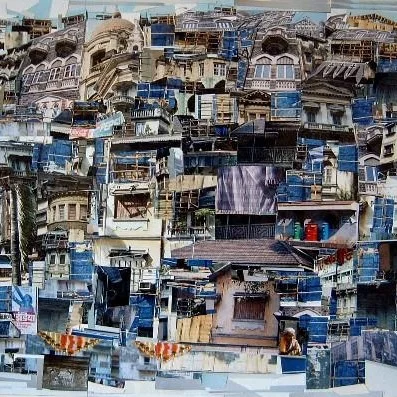The Million-Petaled Flower of Being Here | Oi Fortin
The Million-Petaled Flower of Being Here | Oi Fortin
Oi Fortin in her Erector Square studio. Photo: J. Gleisner.
Before taking her photo, Oi Fortin rises from her stool to don her beige printmaking apron. This smock is practical and comforting explains Fortin, who tells me her first name means “sweetie” in Thai. Around Fortin’s studio, dozens of small, colorful monoprints are drying. With their slender compositions, many of these works evoke the human body: Layers of flat shapes resemble a singular figure on an abstract ground. Fortin’s excitement for her recent success seems humble and natural, though she didn’t begin making art until her 30s.
Born in Bangkok, Thailand, Fortin moved to Wayland, Massachusetts when she was adopted at age 16. Her biological mother had sent her to live with her aunt and uncle as an infant and when they could no longer care for her, Fortin was taken to an orphanage. (However foreign this custom may seem, Fortin explained that it was common—and accepted—for girls to be given away in Thailand.) The adoption process was initiated when Fortin was 11, but it took several years to finalize the paperwork because the orphanage did not have a copy of her birth certificate or any record of her birth. To this day, Fortin remains unsure of the exact year of her birth—she believes she is 61. To her, age is a mindset, not a number.
Oi Fortin, Rhythm (2019). Image courtesy of the artist.
Fortin feels fortunate to have been adopted into a loving family and as she matured, she followed her parents’ example, beginning her career in finance. While on a work trip to Manhattan, she met her husband, then a medical school student at New York University. They got married in 1992 before traveling together to Peshawar, Pakistan with a program called International Medical Corps. When they returned to America, they no longer desired their possessions after having lived at a refugee camp for six months. Selling their belongings, they lived on a tiny sailboat outside Baltimore for the next three years while Fortin resumed working a corporate job.
In 1998, Fortin’s daughter was born, unmooring the structured life her career had provided. When she compared the cost of daycare with her salary, Fortin decided that she would not return to work. She got rid of a closet full of business suits and became a full-time mom. Yet soon Fortin’s life was so centered around the needs of her daughter that she began to lose sight of herself.
Oi Fortin, Mosada (2019). Image courtesy of the artist.
As a baby, Fortin’s daughter was colicky, so they were often both awake at odd hours. Late at night, Fortin would telephone her best friend who lived in California. Her friend listened as Fortin vented about her frustrations with motherhood. Fortin had stopped exercising. She and her husband never seemed to get out of the house. Her friend offered a suggestion: Fortin should sign up for an art class.
Fortin had danced as a young girl in Thailand, but she had never studied art. Still, she enjoyed coloring and doodling, and she was also desperate for a change. She remembered that a former colleague had offered to babysit her daughter. This co-worker was now free on Mondays, so Fortin enrolled in a printmaking course at the Creative Arts Workshop that met that day. Her attraction to monotype was immediate. “What I love about monotype is the process—when you paint onto your plexiglass plate and put the paper on top, the print is the complete opposite from what you expect,” Fortin said. “I love that surprise element.”
She took more courses and began attending printmaking conferences. Within three years, she participated in Artspace’s City-Wide Open Studios event inside the Pirelli Building and to her surprise, Fortin sold nine prints. Then, in 2009, Fortin rented her first studio, splitting the space with another artist whose schedule was opposite hers. When her studio mate wanted to leave, Fortin stayed and took over the lease on her own. Ten years later, she still has the same studio space on the second floor of building eight of Erector Square.
“When you work from your own heart, that will come through and it will allow you to propel yourself forward,” said Fortin, who learned how to reinvent herself—both as a mother and an artist. As Fortin has garnered success, she has also gained confidence. Yet she reminds herself to stay humble: “Don’t take anything too seriously,” she added, “because it’s only art!”
Oi Fortin, Satory (2019). Image courtesy of the artist.
All of Fortin’s quotes are from a conversation with the author at Fortin’s studio in the Fair Haven neighborhood of New Haven, Connecticut on September 3, 2019. Read more about this commissioned project here.







